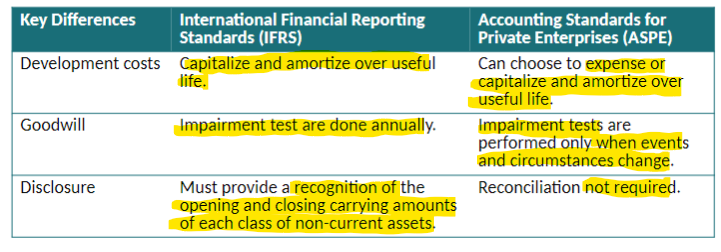chapter 9- long-lived assets
1/39
There's no tags or description
Looks like no tags are added yet.
Name | Mastery | Learn | Test | Matching | Spaced |
|---|
No study sessions yet.
40 Terms
PPE
long lived assets
a “non-current” asset
ex.
buildings
land
includes land improvement
leasehold improvements
right-of-use assets
conditions
controlled by company
tangible
used in operations
not for sale to customers
includes:
acc. amortization
finding cost of PPE
includes:
purchase price
includes non-refundable taxes and duties - discounts or rebates
freight and cost to make it ready for sale
est. cost of dismantling it at end of life
ex.
purchase price = 89,000
freight = 2,400
ready for use = 14,400+1,400
cost = sum of the above = 107,200
je
dr equip. 107,200
cr cash 107,200
classes
land
land improvements
buildings
equipment
Land
cost includes
purchase price + closing costs + costs to prepare land for use - any proceeds from salvage
ex. of closing costs
surveying land
title search
legal fees
has unlimited life
NO DEPRECIATION
ex. of expensed to land for
restoration costs
land improvements
costs of turning into a property
ex.
paving
fencing
making sidewalks
decline in service potential over time
therefore → recorded separate from land
depreciation occurs
does NOT include:
cost of making land ready for use
this is under “land”
buildings
cost includes:
purchase price + closing costs aka legal fees + cost of making building ready for use + construction costs - disposal proceeds
constructing
contract price
architect fees
building permits
excavation cost
interest costs
equip.
cost include
purchase price + purchasers freight charges + assembling + installing + testing
includes sales tax or cost of ins.
2 types of expenses during useful life
operating expenditures
benefits only the current period
maintenance to keep the asset at normal operating condition or cosmetic reasons
ex.
repairs
purchasing oil and gas for truck
replacing tires
paint jobs
je
dr expense
cr cash
capital expenditures
increases cost of asset
aka capitalizing an asset
increases:
life of asset
productivity
efficiency
ex.
replacing roof
purchasing buildings
purchasing ins. on equip. on transit
purchasing truck
anticipated retirement costs
adding a new wing to a building
je
dr ppe account
cr cash
leasing
pros
little to no down payment
low risk of obsolescence
cash outlays
instead of paying up front
100% financing
income tax advantage
lessor
owner of an asset for lease
ex. a landlord
lessee
person who’s leasing
ex. a tenant
obsolescence
being outdated or no longer in use due to the emergence of newer, more advanced alternatives or technologies
leasing rules IFRS
defines a lease as
an asset purchase financed with a loan provided by the lessor (owner)
risk and rewards of ownership transferred to lessee (renter) even though legal title has not passed
lessee (renter) needs to report the asset as a “right-of-use asset” and the related liability
lease can be treated as a period expense
conditions:
lease term is less than 12 months
the asset is low-value
lease rules for ASPE
2 types of leases
capital lease
all benefits and risk transferred to lessee
lessee needs to record the leased asset and related liab. at present value of min. lease payments
operating lease
benefits and risks NOT transferred to lessee
lease payment recorded as
expense for lessee
rev. for lessor
depreciation
allocation of the cost of a PPE over the asset’s useful life
does not determine current value of asset
does not use cash or provide cash to replace the asset
calculating depr.
factors
cost
purchase price + cost to get asset ready for use + est. asset retirement costs
useful life
period of time asset is expected to be used
or
# of units asset expected to produce
aka units of output expected
residual value
est. amount to be received from disposal at end of life
what it is expected to be sold for at end of life
depr. methods
methods:
straight-line
diminishing-balance
units-of-production
how to choose?
which best reflects the pattern of use of the benefits from the asset
if asked “ what depr. method should be used?”
do all 3 methods and find the one with the lowest depr. expense for the year

MAIN EXAMPLE
delivery van bought on Jan. 1, 2024
each method will give same total depreciable amount
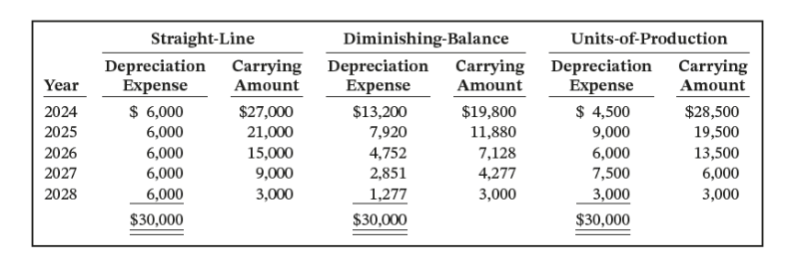
straight line method
depr. is constant for each year
straight-line rate
100%/# of years in use = rate per year
100%/5 years = 20%/yr
je
dr. depr. expense
cr. acc. depr. - (ppe)
ex.
equipment cost = 143,770
on jan. 1, 2022
resid = 4190
useful life = 5
what is the je for depr. for sept. 30, 2024
cost - resid. = depr. amount
143,770-4190 = 139580
depr. expense = depr. amount/useful life
139,580/5 = 27916
27,916/12 = 2326.33333
jan → sept = 9 months so,
2326.3333×9 = 20,937
dr. depr. expense 20,937
cr. acc depr. - equip 20937
the depr. expense for the next time will be calculated based on the depr. amount of the last time
ex.
if last calc. on dec. 31, 2024 and next one on nov. 30 2025
see how much depr. expense elapsed from last to next by: acc. depr. - last depr. expense = nov 30 depr. expense
to get carrying amount
purchase amount - depr. expense or acc. depr.

diminishing balance method
annual depr. decreases over the useful life of asset cuz based on carrying amount
declines each yr cuz acc. depr. increases each yr
depr. expense = carrying amount at start of yr* depr. rate
residual value not included
depr. rate = straight-line rate * multiplier
best if most use is in the earlier years of operation

db method ex.
purchased truck jan. 1, 2024 = 104,000
residual = 10,400
useful life = 4 yrs
depr. rate = 2x the straight-line rate
depr. rate = 100%/4 years = 25%
25%*2 = 50%
2024 yr-end
104,000×50% = 52000 depr. expense
104,000-52,000 = 52,000 (new carrying amount) and so on
when you get to the last yr. or when next carrying amount is below residual
do last carrying amount - residual
13,000 - 10,400 = 2,600 depr. expense
units-of-production method
useful life = total units of production or activity expected from asset
ex.
units produced
hours machine is worked
best way for:
factory machinery
vehicles
airplanes
any asset whose usage changes over time → seasonal
depreciable amount = cost - residual value
depr. rate/unit = depr. amount/est. total units of production
depr. expense = depr rate/unit*units of production in yr
ex.
cost = 35,370
resid. = 520
expected km. to be driven = 348,500
amount driven in 2023 = 104,370
amount driven in 2024 = 115,630
cost-resid = depr. amount
35,370 -520 = 34,850
depr. amount/ expected km. to be driven = depr. rate
34,850/348,500 = 0.1
now get depr exp. for each yr
0.1×104,370 = 10,437 for 2023
0.1×115,630 = 11,563 for 2024

getting carrying amount for UofP depr.
purchase amount - depr. expense
for any year
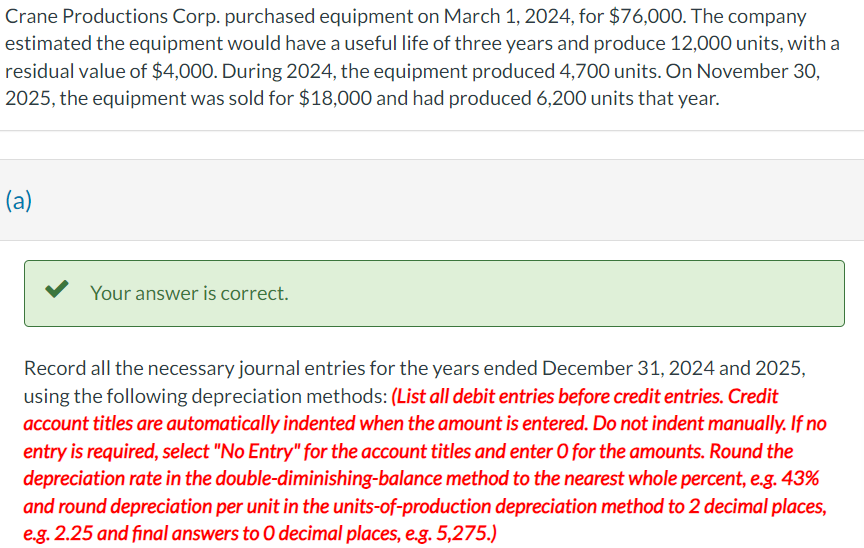
MAIN EX. 2
march 1 entry is always the same
for sale always:
cash = 18,000
equipment = 76,000
only things that change are:
acc. depr.
gain or loss
months between march 1 2024 and dec. 31 2024 = 10 months
months between dec. 31 2024 and nov. 30 2025 = 11 months
straight line for main ex. 2
dec.31
cost - resid = depr. amount
76,000 - 4,000 = 72,000
/3 = depr. expense per year
72,000/3 = 24,000
/12 = depr. expense per month
24,000/12 = 2,000
march 1 to dec. 31 = 10 months so,
2,000×10 = 20,000
nov. 30
depr. expense
dec. 31 2024 to nov. 30 2025 = 11 months so,
11×2000 = 22,000
sale
acc. depr equip.
20,000+22,000 = 42,000
loss or gain
76,000 -( 18,000 +42,000) = 16,000
positive = loss

db for main ex. 2
dec. 31
100%/3yrs = 0.33333 depr. rate
“double diminishing” = 0.33333×2 = 0.6666 = 0.67
cost*0.67 = depr. expense per year
76,000×0.67 = 50,920
/12 = depr. expense per month
50,920/12 = 4,243.3333
*10 = depr. expense from march to dec. 31
4,243.3333×10 = 42,433
nov 30
depr. expense
cost - last depr. exp. = new carrying amount
76,000-42,433 = 33,567
*0.67 = depr. exp. per year
33,567×0.67 = 22,489.89
/12 = depr. expense per month
22,489.89/12 = 1,874.1575
*11 = depr. expense
1,874.1575×11 = 20,616
sale
acc. depr = 42,433+20,616 = 63,049
gain or loss
76,000-(18,000+63,049) = -5049
negative =gain

uofp for main ex. 2
for uofp dates do not matter only amount of units
dec. 31
76,000-4,000 = 72,000
/12,000 units = depr. per unit
72,000/12,000 = 6
6*units for 2024
6×4,700 = 28,200
nov. 30
depr. expense
6×6,200 = 37,200
sale
acc. depr = 37,200+28,200 = 65,400
gain or loss
76,000-(18,000+65,400) = -7,400
negative = gain
revising depr.
revision need if:
change in est. useful life or residual value
capital expenditures (additions during useful life
impairment
change in pattern of econ. benefits are consumed
revision is account for as a change in estimate
shown in current and future yrs not previous yrs
to get the changed depreciation expenses after the date of revision:
straight line
latest carrying amount - the revised residual then /revised amount of useful life = depreciation expenses
recording asset impairments
when carrying amount > fair value
diff. = amount of loss recorded
indicators of impair. need to be found on a daily basis
if present → do impair. test
record as:
dr Impairment loss
cr respective Acc. Depr. account
results in a revision of the depr. estimate
accounting for natural resources
consumed physically over time
aka wasting assets
depr. of natural resources is called depletion
depr. method is usually units-of-prod.
cuz production can vary form yr to yr
reserve values = fair value of resource
impairment will occur if: reserve value<carrying amount
significant components
may depr. separately
cost vs. revaluation model
revaluation allowed under IFRS but used on a limited basis

selling PPE
need to record disposal
removal of cost of asset and acc. depr.
records proceeds if any
record gain or loss on disposition if any
retirement of asset
same as disposal except little to no proceed of disposition
ex.
equipment cost = 143,770
on jan. 1, 2022
resid = 4190
useful life = 5
what is the je for selling on sept. 30, 2024
cost - resid. = depr. amount
143,770-4190 = 139580
depr. expense = depr. amount/useful life
139,580/5 = 27916
27,916/12 = 2326.33333
jan → sept = 9 months so,
2326.3333×9 = 20,937
so, acc. depr. is:
acc. depr = 2022, 2023, and 2024 depr.
acc. depr = 27,916+27,916+20,937 = 76,769
use to get loss or gain on disposal
cost - (how much sold for + acc. depr.)
143,770(40,550+76,769) = 26,451
positive = loss
negative = gain
je
dr
cash 40,550
acc. depr.- equip. 76,769
loss on disposal 26,451
cr
equipment 143,770
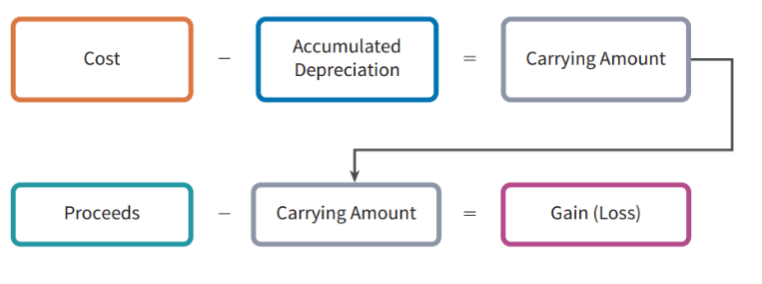
intangible assets
not physical
they are:
rights
ex.
franchise
license
privileges
competitive advantages
ex.
intellectual property
patents
trademark
needs to be identifiable
can be:
separated from company, sold, licensed or rented
based on contractual or legal rights
how its accounted
recorded at cost + costs to make ready for use
includes:
developmental costs
intangibles finite vs. infinite life
if intangible has a finite life → cost will be allocated over useful life
amortization
depreciation is for tangibles
over est. useful or legal life
whichever is lower
needs to be tested for impairment and write-down when needed
ex.
patents
right to produce for 20 yrs
copyrights
protection for lifetime of creator + 50 yrs
research and develop. costs
all research costs expensed
develop. costs only capitalized if associated w/ a identifiable, feasible product
if intangible had a infinite life
no amortization
ex.
trademarks or trade names
word
phrase
jingle
symbol
franchises
contract to sell products
licenses
grant operating rights
goodwill
represent future benefits from the purchasing of the business
extra cost on top of fair market value of net identifiable assets (assets - liab.)
extra value of business when purchased
only identifiable w/ the business as a whole
not amortized
subjected to annual test of impair.
ex.
market value of assets = 1,100,000
liab. = 600,000
company sold for = 650,000
good will?
market value of assets - liab.
1,100,000-600,000 = 500,000
company sold for-500,000
650,000-500,000 = 150,000 (good will)
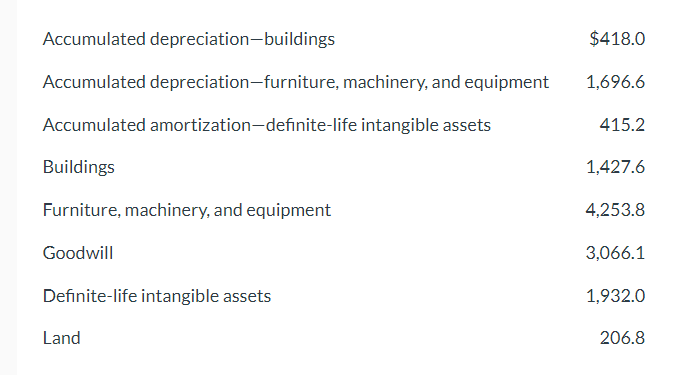
long-lived assets in state. of fp
non-current asset under:
PPE
Intangible assets
Goodwill
shows cost and acc. depr of each
can be in statement or notes
disclose depr./amortization methods and useful lives or rates
more disclosures for IFRS

Long-lived assets in state of inc.
under operating expenses
depr. expense
amortization expense
gains and losses on disposal
impairment losses
repairs and maintenance expense
ex.
vehicle license fee
vehicle expense
buying a new one
painting to advertise the truck
long-lived assets on state. of cash flows
under investing:
cash flows from purchase and sale of long-lived assets
return on assets
measures profitability
return on assets = net income/ avg. total assets
or
profit margin*asset turnover = return on assets
profit margin = gross profit/rev.
profit margin and asset runover explain the return on assets ratio
ex.
A
return on assets = 8.9%
asset turnover = 0.4
B
return on assets = 8.3%
asset turnover = 0.8
gross profit = return on assets/asset turnover
0.0089/0.4 = 22.3%
0.0083/0.8 = 10.4%
higher = better
shows that for every $ invested in assets = more net income
asset turnover
how efficiently assets are being used
asset turnover= sales/ avg. total assets
high = better
shows that for every $ invested into assets → more sales
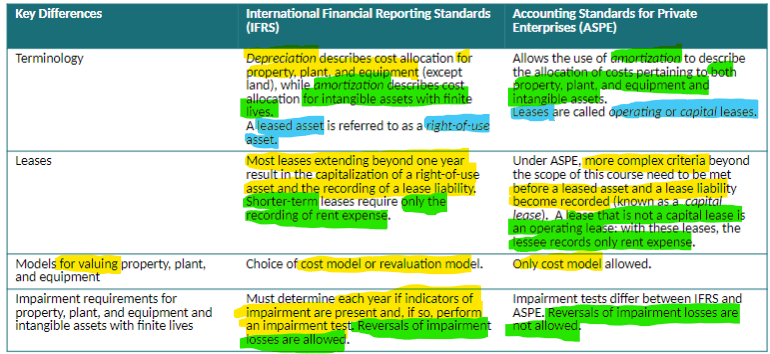
IFRS vs. ASPE
